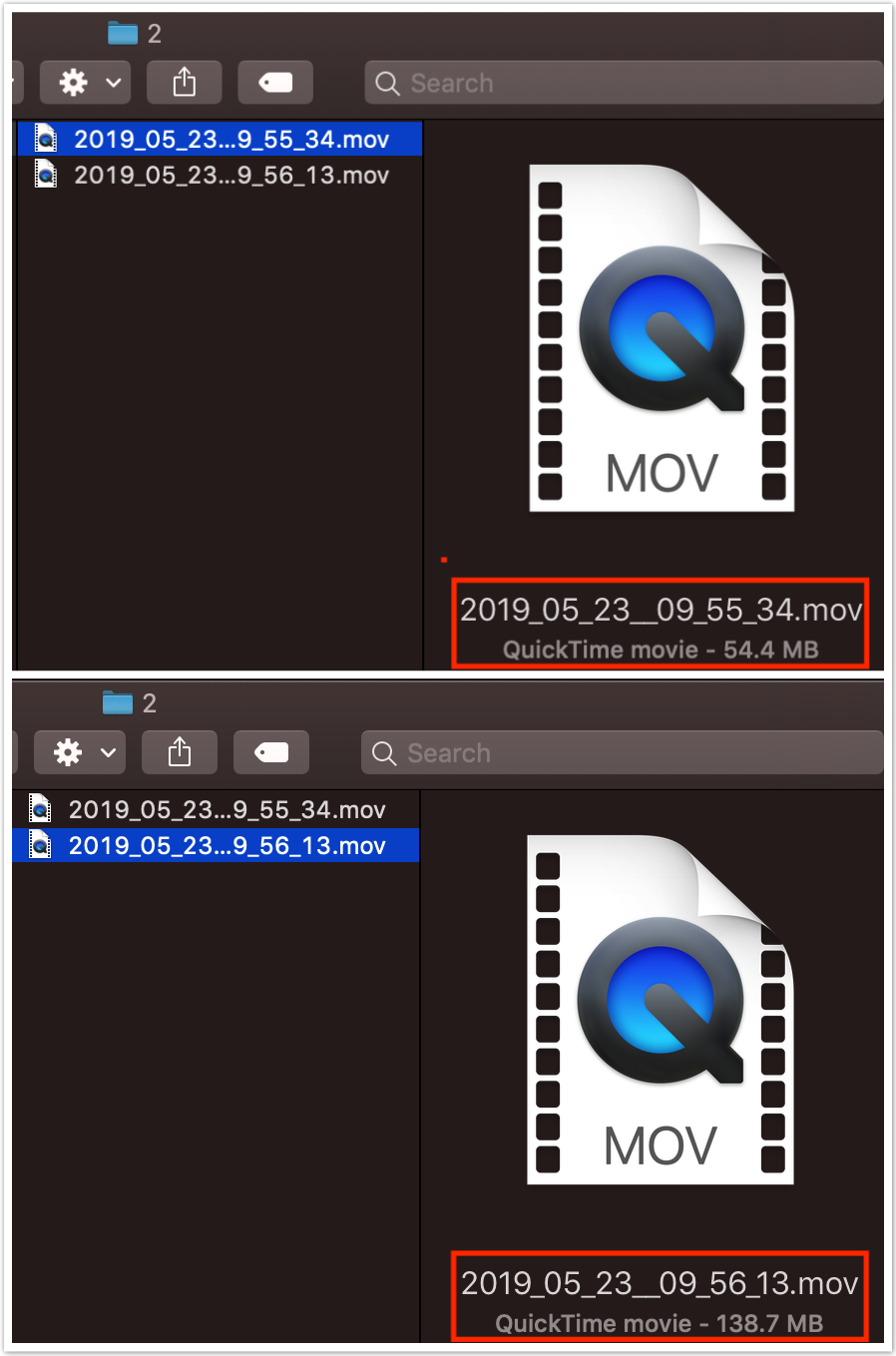需求
iOS中编码视频数据,一般情况而言一个项目仅需要一个编码器,不过有时特殊需求可能需要两个编码器同时工作.本例中实现了编码器类.仅通过指定不同编码器的枚举值就可以快速生成需要的编码器,且支持两个编码器一起工作.
实现原理:
iOS中利用VideoToolBox框架完成视频硬编码操作,支持H.264,H.265编码器.
软编码:使用CPU进行编码。
硬编码:不使用CPU进行编码,使用显卡GPU,专用的DSP、FPGA、ASIC芯片等硬件进行编码。
阅读前提:
- 音视频基础知识
- 推荐必读:H264, H265硬件编解码基础及码流分析
- 视频采集:iOS视频采集实战(AVCaptureSession)
- C,C++基础
GitHub地址(附代码) : Video Encoder
掘金地址 : Video Encoder
简书地址 : Video Encoder
博客地址 : Video Encoder
测试结果
本例通过将编码后的文件写成.mov文件, 来测试h264, h265编码效率, 录制时间相同,场景基本相同,结果显示h265仅需要h264一半的内存就可以完成同样的画质.注意,录制出来的文件只能用ffmpeg相关工具播放.
实现步骤
1. 初始化编码器参数
本例中的编码器类不是单例,因为我们可以生成出h264编码器,h265编码器,以及让生成两个不同类型编码器对象同时工作.这里指定的宽高帧率需要与相机保持一致. 比特率即播放过程中平均码率,是否支持实时编码,如果支持实时编码码率则无法控制.最后我们仅仅可以通过指定编码器的类型来决定创建h264编码器还是h265编码器.
- 判断是否支持编码器
判断是否支持hevc编码器,并不是所有的设备都支持h265编码器,这由硬件决定,但是没有直接的API去判断是否支持h265编码器,在这里借助AVAssetExportPresetHEVCHighestQuality属性来间接判断是否支持h265编码.
注意: h265编码的软件API需要在iOS 11以上的操作系统才能使用. 目前所有流行的iPhone已都支持h264编码器.
1 | // You could select h264 / h265 encoder. |
2. 初始化编码器
初始化一个编码器分为以下三个步骤, 首先新建一个VTCompressionSessionRef引用对象管理编码器, 然后将编码器所有属性赋值给该对象.最后在编码前预先分配一些资源(即为要编码的数据预先分配内存)以便编码buffer使用.1
2
3
4
5
6
7
8
9
10
11
12
13
14
15
16
17
18
19
20
21
22
23
24
25
26
27
28
29
30
31
32
33
34
35
36
37
38
39
40
41
42
43
44
45
46
47
48
49
50
51- (void)configureEncoderWithWidth:(int)width height:(int)height {
log4cplus_info("Video Encoder:", "configure encoder with and height for init,with = %d,height = %d",width, height);
if(width == 0 || height == 0) {
log4cplus_error("Video Encoder:", "encoder param can't is null. width:%d, height:%d",width, height);
return;
}
self.width = width;
self.height = height;
mSession = [self configureEncoderWithEncoderType:self.encoderType
callback:EncodeCallBack
width:self.width
height:self.height
fps:self.fps
bitrate:self.bitrate
isSupportRealtimeEncode:self.isSupportRealTimeEncode
iFrameDuration:30
lock:self.lock];
}
- (VTCompressionSessionRef)configureEncoderWithEncoderType:(XDXVideoEncoderType)encoderType callback:(VTCompressionOutputCallback)callback width:(int)width height:(int)height fps:(int)fps bitrate:(int)bitrate isSupportRealtimeEncode:(BOOL)isSupportRealtimeEncode iFrameDuration:(int)iFrameDuration lock:(NSLock *)lock {
log4cplus_info("Video Encoder:","configure encoder width:%d, height:%d, fps:%d, bitrate:%d, is support realtime encode:%d, I frame duration:%d", width, height, fps, bitrate, isSupportRealtimeEncode, iFrameDuration);
[lock lock];
// Create compression session
VTCompressionSessionRef session = [self createCompressionSessionWithEncoderType:encoderType
width:width
height:height
callback:callback];
// Set compresssion property
[self setCompressionSessionPropertyWithSession:session
fps:fps
bitrate:bitrate
isSupportRealtimeEncode:isSupportRealtimeEncode
iFrameDuration:iFrameDuration
EncoderType:encoderType];
// Prepare to encode
OSStatus status = VTCompressionSessionPrepareToEncodeFrames(session);
[lock unlock];
if(status != noErr) {
log4cplus_error("Video Encoder:", "create encoder failed, status: %d",(int)status);
return NULL;
}else {
log4cplus_info("Video Encoder:","create encoder success");
return session;
}
}
2.1. 创建VTCompressionSessionRef对象
VTCompressionSessionCreate: 创建视频编码器session, 即管理编码器上下文的对象.
- allocator: session的内存分配器.传递NULL表示默认的分配器.
- width,height: 指定编码器的像素的宽高,与捕捉到的视频分辨率保持一致
- codecType: 编码器类型.目前可用h264, h265两种主流编码器,h264应用最为广泛.h265编码器是h264的下一代,压缩性能更高,不过刚在iOS11中开放出来,存在一些bug.
- encoderSpecification: 指定必须使用特定的编码器.一般传NULL即可.video toolbox会自己选择.
- sourceImageBufferAttributes: 原始视频数据需要的属性.主要用于创建
a pixel buffer pool. - compressedDataAllocator: 压缩数据的内存分配器.传NULL表示使用默认的分配器.
- outputCallback: 接收压缩数据的回调.这个回调可以选择使用同步或异步方式接收.如果用同步则与
VTCompressionSessionEncodeFrame函数线程保持一致,如果用异步会新建一条线程接收.该参数也可传NULL不过当且仅当我们使用VTCompressionSessionEncodeFrameWithOutputHandler函数作编码时. - outputCallbackRefCon: 可以传入用户自定义数据.主要用于回调函数与主类之间的交互.
- compressionSessionOut: 传入要创建的session的内存地址.注意,session不能为NULL.
1 | VT_EXPORT OSStatus |
下面是具体用法.注意如果相机采集的分辨率改变,需要销毁当前编码器session重新创建.
1 | - (VTCompressionSessionRef)createCompressionSessionWithEncoderType:(XDXVideoEncoderType)encoderType width:(int)width height:(int)height callback:(VTCompressionOutputCallback)callback { |
2.2. 设置session属性
- 查询session是否支持当前属性
创建好session后,调用VTSessionCopySupportedPropertyDictionary函数可以将当前session支持的所有属性拷贝到指定的字典中,以后在设置属性前先在字典中查询是否支持即可.1
2
3
4
5
6
7
8
9
10
11
12
13- (BOOL)isSupportPropertyWithSession:(VTCompressionSessionRef)session key:(CFStringRef)key {
OSStatus status;
static CFDictionaryRef supportedPropertyDictionary;
if (!supportedPropertyDictionary) {
status = VTSessionCopySupportedPropertyDictionary(session, &supportedPropertyDictionary);
if (status != noErr) {
return NO;
}
}
BOOL isSupport = [NSNumber numberWithBool:CFDictionaryContainsKey(supportedPropertyDictionary, key)].intValue;
return isSupport;
}
- 设置session的属性
使用VTSessionSetProperty函数指定key, value即可设置属性.1
2
3
4
5
6
7
8
9
10
11- (OSStatus)setSessionPropertyWithSession:(VTCompressionSessionRef)session key:(CFStringRef)key value:(CFTypeRef)value {
if (value == nil || value == NULL || value == 0x0) {
return noErr;
}
OSStatus status = VTSessionSetProperty(session, key, value);
if (status != noErr) {
log4cplus_error("Video Encoder:", "Set session of %s Failed, status = %d",CFStringGetCStringPtr(key, kCFStringEncodingUTF8),status);
}
return status;
}
- kVTCompressionPropertyKey_MaxFrameDelayCount: 编码器在输出压缩帧前允许保留的最大帧数.默认为kVTUnlimitedFrameDelayCount,即不限制保留帧数.比如当前要编码10帧数据,最大延迟帧数为3(M), 那么在编码10(N)帧视频数据时,10-3(N-M)帧数据必须已经发送给编码回调.即已经编好了N-M帧数据,还保留M帧未编码的数据.
- kVTCompressionPropertyKey_ExpectedFrameRate: 期望帧率,帧率以每秒钟接收的视频帧数量来衡量.此属性无法控制帧率而仅仅作为编码器编码的指示.以便在编码前设置内部配置.实际取决于视频帧的duration并且可能是不同的.默认是0,表示未知.
- kVTCompressionPropertyKey_AverageBitRate: 长期编码的平均码率.此属性不是一个绝对设置,实际产生的码率可能高于此值.默认为0,表示编码器应该自行决定编码数据的大小.注意,码率设置仅在为原始帧提供定时信息时有效,并且某些编解码器不支持限制到指定的码率。
- kVTCompressionPropertyKey_DataRateLimits: 可以选择两个以下的硬性限制对于码率.每个硬限制由以字节为单位的数据大小和以秒为单位的持续时间来描述,并要求该持续时间(在解码时间内)的任何连续段的压缩数据的总大小不得超过数据大小。默认情况下,不设置数据速率限制。该属性是偶数个CFNumber的CFArray,在字节和秒之间交替。请注意,数据速率设置仅在为原始帧提供定时信息时有效,并且某些编解码器不支持限制指定的数据速率。
- kVTCompressionPropertyKey_RealTime: 是否实时执行压缩.false表示视频编码器可以比实时更慢地工作,以产生更好的结果.设置为true可以更加及时的编码.默认为NULL,表示未知.
- kVTCompressionPropertyKey_AllowFrameReordering: 如果编码器开启B帧,则时间会乱序,编码器必须重新排序.默认为True,将其设置为false以防止帧重新排序.注意: iOS中一般不用相机采集B帧.
- kVTCompressionPropertyKey_ProfileLevel: 指定编码比特流的配置文件和级别。可用的配置文件和级别因格式和视频编码器而异。视频编码器应该在可用的地方使用标准密钥,而不是标准模式。
- kVTCompressionPropertyKey_H264EntropyMode: H.264压缩的熵编码模式。如果H.264编码器支持,则此属性控制编码器是使用基于上下文的自适应可变长度编码(CAVLC)还是基于上下文的自适应二进制算术编码(CABAC)。CABAC通常以更高的计算开销为代价提供更好的压缩。默认值是编码器特定的,可能会根据其他编码器设置而改变。使用此属性时应小心 - 更改可能会导致配置与请求的配置文件和级别不兼容。这种情况下的结果是未定义的,可能包括编码错误或不符合要求的输出流。
- kVTCompressionPropertyKey_MaxKeyFrameIntervalDuration: 从一个关键帧到下一个关键帧的最长持续时间(秒)。默认为零,没有限制。当帧速率可变时,此属性特别有用。此键可以与
kVTCompressionPropertyKey\_MaxKeyFrameInterval一起设置,并且将强制执行这两个限制 - 每X帧或每Y秒需要一个关键帧,以先到者为准。 - kVTCompressionPropertyKey_MaxKeyFrameInterval: 关键帧之间的最大间隔,以帧的数量为单位。关键帧,也称为I帧,重置帧间依赖关系;解码关键帧足以准备解码器以正确解码随后的差异帧。允许视频编码器更频繁地生成关键帧,如果这将导致更有效的压缩。默认关键帧间隔为0,表示视频编码器应选择放置所有关键帧的位置。关键帧间隔为1表示每帧必须是关键帧,2表示至少每隔一帧必须是关键帧等此键可以与kVTCompressionPropertyKey_MaxKeyFrameIntervalDuration一起设置,并且将强制执行这两个限制 - 每X帧或每Y秒需要一个关键帧,以先到者为准。
1 | // Set compresssion property |
2.3. 编码前资源分配
您可以选择调用此函数,以便为编码器提供在开始编码帧之前执行任何必要资源分配的机会。此可选调用可用于为编码器提供在开始编码帧之前分配所需资源的机会。如果未调用此方法,则将在第一个VTCompressionSessionEncodeFrame调用上分配任何必要的资源。额外调用此函数将不起作用。1
2
3
4
5
6
7
8
9
10// Prepare to encode
OSStatus status = VTCompressionSessionPrepareToEncodeFrames(session);
[lock unlock];
if(status != noErr) {
log4cplus_error("Video Encoder:", "create encoder failed, status: %d",(int)status);
return NULL;
}else {
log4cplus_info("Video Encoder:","create encoder success");
return session;
}
执行到这里,初始化编码器的工作已经做完,接下来我们需要将视频帧数据进行编码. 本例中使用AVCaptureSession采集视频帧以传给编码器编码.
3.编码
注意,因为编码线程与创建,销毁编码器过程属于异步操作,所以需要加锁.
- 时间戳同步
首先我们取第一帧视频数据为基准点,取系统当前时间,作为编码第一帧数据的基准时间. 此操作主要用于后期的音视频同步,本例中不作过多说明,另外,时间戳同步生成机制也不像本例中这么简单.可以自行制定生成规则.
- 时间戳校正
判断当前编码的视频帧中的时间戳是否大于前一帧, 因为视频是严格按时间戳排序播放的,所以时间戳应该是一直递增的,但是考虑到传给编码器的可能不是一个视频源,比如一开始是摄像头采集的,后面换成从网络流解码的视频原始数据,此时时间戳必定不同步,如果强行将其传给编码器,则画面会出现卡顿.
- 编码视频帧
- session: 先前配置好的session
- imageBuffer: 原始视频数据
- presentationTimeStamp: 视频帧的pts
- duration: 此帧的持续时间,将附加到样本缓冲区。如果没有持续时间信息,传kCMTimeInvalid。
- frameProperties: 指定视频帧的其他属性,这里以是否强制产生I帧为例.
- sourceFrameRefcon: 可以传递给回调函数原始帧的引用.
- infoFlagsOut: 指向VTEncodeInfoFlags以接收有关编码操作的信息。如果编码是(或正在)异步运行,则可以设置kVTEncodeInfo_Asynchronous位。如果帧被丢弃(同步),则可以设置kVTEncodeInfo_FrameDropped位。如果您不想接收此信息,请传递NULL。
1 | VT_EXPORT OSStatus |
1 | -(void)startEncodeWithBuffer:(CMSampleBufferRef)sampleBuffer session:(VTCompressionSessionRef)session isNeedFreeBuffer:(BOOL)isNeedFreeBuffer isDrop:(BOOL)isDrop needForceInsertKeyFrame:(BOOL)needForceInsertKeyFrame lock:(NSLock *)lock { |
4. h264码流 - H264, H265硬件编解码基础及码流分析
以下关于码流部分的代码如果看不懂,建议一定要先看下标题推荐的链接,里面是了解编解码器的基础知识以及iOS中VideoToolbox框架中数据结构的解析.
5. 回调函数
- 排错校验
如果status中有错误信息,表示编码失败.可以做一些特殊处理.
- 时间戳纠正
我们需要为编码后的数据填充时间戳,这里我们可以根据自己的规则制定一套时间戳生成规则,我们这里仅仅用最简单的偏移量,即用第一帧视频数据编码前系统时间为基准点,然后每帧编码后的时间取采集到的时间戳减去基准时间得到的值作为编码后数据的时间戳.
- 寻找I帧.
原始视频数据经过编码后分为I帧,B帧,P帧.iOS端一般不开启B帧,B帧需要重新排序,我们拿到编码后的数据首先通过kCMSampleAttachmentKey_DependsOnOthers属性判断是否为I帧,如果是I帧,要从I帧中读取NALU头部关键信息,即vps,sps,pps. vps仅在h265编码器中才有.没有这些编码的视频无法在另一端播放,也无法录制成文件.
- 读取编码器关键信息
从I帧中可以读取到vps,sps,pps数据具体的内容.如果是h264编码器调用CMVideoFormatDescriptionGetH264ParameterSetAtIndex函数,如果是h265编码器调用CMVideoFormatDescriptionGetHEVCParameterSetAtIndex函数,其中第二个参数的索引值0,1,2就分别代表这些数据的索引值.
找到这些数据后我们需要将它们拼接起来,因为它们是独立的NALU,即以0x00, 0x00, 0x00, 0x01作为隔断符以区分sps,pps.
所以,我们按照规则将拿到的vps,sps,pps中间分别以00 00 00 01作为隔断符以拼接成一个完整连续的buffer.本例以写文件为例,我们首先要将NALU头信息写入文件,也就是将I帧先写进去,因为I帧代表一个完整图像,P帧需要依赖I帧才能产生图像,所以我们文件的读取开头必须是一个I帧数据.
- 一帧图片跟NALU的关联:
一帧图片经过 H.264 编码器之后,就被编码为一个或多个片(slice),而装载着这些片(slice)的载体,就是 NALU 了。
注意:片(slice)的概念不同与帧(frame),帧(frame)是用作描述一张图片的,一帧(frame)对应一张图片,而片(slice),是 H.264 中提出的新概念,是通过编码图片后切分通过高效的方式整合出来的概念,一张图片至少有一个或多个片(slice)。片(slice)都是又 NALU 装载并进行网络传输的,但是这并不代表 NALU 内就一定是切片,这是充分不必要条件,因为 NALU 还有可能装载着其他用作描述视频的信息。
- 分割码流中的NALU
首先通过CMBlockBufferGetDataPointer获取视频帧数据.该帧表示一段H264/H265码流,其中可能包含多个NALU,我们需要找出每个NALU并用00 00 00 01作为隔断符. 即while循环就是寻找码流中的NALU,因为裸流中不含有start code.我们要将start code拷贝进去.
CFSwapInt32BigToHost: 从h264编码的数据的大端模式(字节序)转系统端模式
1 | static void EncodeCallBack(void *outputCallbackRefCon,void *souceFrameRefCon,OSStatus status,VTEncodeInfoFlags infoFlags, CMSampleBufferRef sampleBuffer) { |




